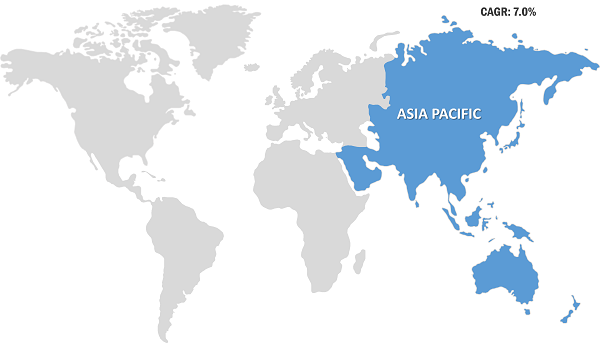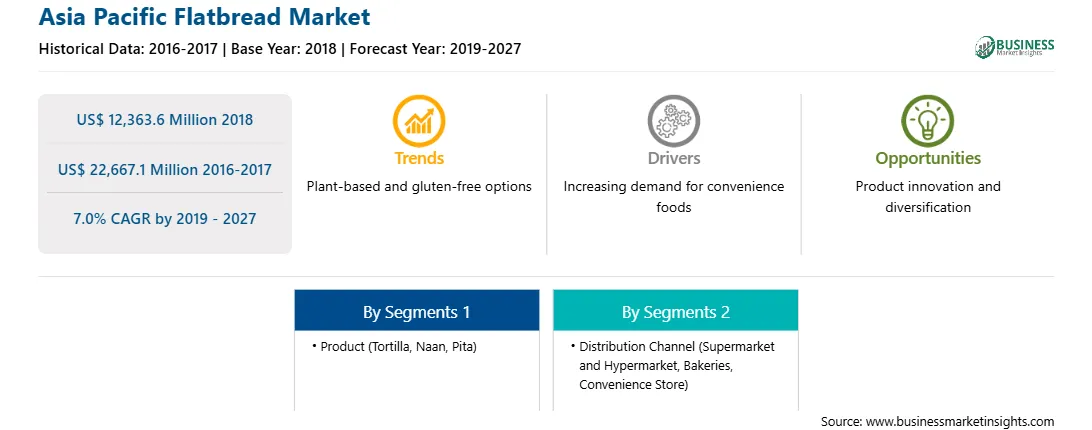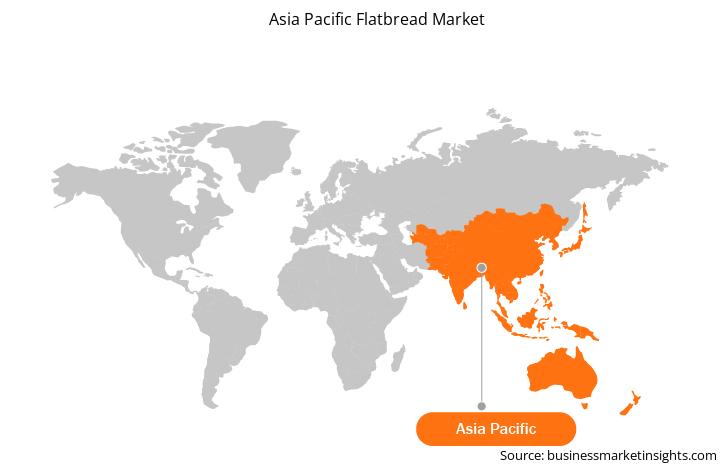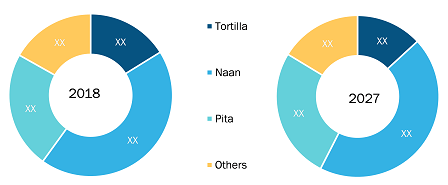A flatbread is a bread made with water, flour, and salt, and then thoroughly rolled into flattened dough. Traditionally, flatbread is an unleavened bread that is made without yeast. Flour, water, and salt are the main ingredients used for making flatbread. Other ingredients such as corn, rye, millet, and barley are also used for making flatbread. The consumers in developed countries, such as the China and Japan, are becoming more health-conscious owing to limitless access to online information. This has positively affected the growth of businesses looking to flatbread market. Health-conscious consumers are more likely to look for specific information associated with the food products they are purchasing. Rising consumer awareness regarding health is propelling the demand for healthy, flatbread products such as low fat and sugar, favoring the flatbread market. Additionally, factors such as consumer awareness of health issues, higher personal incomes, a greater focus on fitness, and rapid urbanization are driving the demand for healthy flatbread products. Major producers in the flatbread market are constantly focusing on introducing flatbread products that are rich in nutrients to attract a new consumer segment in developed countries.
The surge in demand for healthy flatbread options has subsequently propelled the demand for healthy flatbread products such as tortilla, pita, Lavash, and chapattis. Tortillas are a high source of fiber, calcium, folic acid, vitamin B complex, and energy. The high fiber content in tortillas helps improve gastrointestinal function. The folic acid is an essential vitamin for pregnant women as it helps in the formulation of fetus nervous system that has been one of the contributing factors for the rise and expansion of the flatbread market in the Asia Pacific region.

Strategic insights for the Asia Pacific Flatbread provides data-driven analysis of the industry landscape, including current trends, key players, and regional nuances. These insights offer actionable recommendations, enabling readers to differentiate themselves from competitors by identifying untapped segments or developing unique value propositions. Leveraging data analytics, these insights help industry players anticipate the market shifts, whether investors, manufacturers, or other stakeholders. A future-oriented perspective is essential, helping stakeholders anticipate market shifts and position themselves for long-term success in this dynamic region. Ultimately, effective strategic insights empower readers to make informed decisions that drive profitability and achieve their business objectives within the market.

| Report Attribute | Details |
|---|---|
| Market size in 2018 | US$ 12,363.6 Million |
| Market Size by 2027 | US$ 22,667.1 Million |
| Global CAGR (2019 - 2027) | 7.0% |
| Historical Data | 2016-2017 |
| Forecast period | 2019-2027 |
| Segments Covered |
By Product
|
| Regions and Countries Covered | Asia-Pacific
|
| Market leaders and key company profiles |
The geographic scope of the Asia Pacific Flatbread refers to the specific areas in which a business operates and competes. Understanding local distinctions, such as diverse consumer preferences (e.g., demand for specific plug types or battery backup durations), varying economic conditions, and regulatory environments, is crucial for tailoring strategies to specific markets. Businesses can expand their reach by identifying underserved areas or adapting their offerings to meet local demands. A clear market focus allows for more effective resource allocation, targeted marketing campaigns, and better positioning against local competitors, ultimately driving growth in those targeted areas.

The consumers in developed countries, such as the US, and Canada, are becoming more health-conscious owing to limitless access to online information. This has positively affected the growth of businesses looking to flatbread market. Health-conscious consumers are more likely to look for specific information associated with the food products they are purchasing. Rising consumer awareness regarding health is propelling the demand for healthy, flatbread products such as low fat and sugar. Additionally, factors such as consumer awareness of health issues, higher personal incomes, a greater focus on fitness, and rapid urbanization are driving the demand for healthy flatbread products. Major producers in the market are constantly focusing on introducing flatbread products that are rich in nutrients to attract a new consumer segment in developed countries. The surge in demand for healthy flatbread options has subsequently propelled the demand for healthy flatbread products such as tortilla, pita, Lavash, and chapattis. Tortillas are a high source of fiber, calcium, folic acid, vitamin B complex, and energy. The high fiber content in tortillas helps improve gastrointestinal function. The folic acid is an essential vitamin for pregnant women as it helps in the formulation of fetus nervous system.
The Asia Pacific flatbread market is segmented on the basis of product type as – tortilla, naan, pita, and others. The naan segment in the Asia Pacific flatbread market is estimated to hold a leading share in the market. Naan is a leavened bread which is a major part of cuisines in South Asia, West Asia, Central Asia, and the Carribeans. Naan is cooked inside a hot tandoor, a cylindrical clay and brick oven which has a dome-shaped top. The naan dough is hurled at the wall of the tandoor where it sticks. The naan is allowed to bake until it puffs up and is charred slightly in spots. It is then removed from the tandoor with a stake. Naan in many regions of Asia is a famous flatbread which goes well with gravy dishes. The large expat population of people of South Asian and Central Asian heritage in the West have been responsible for introducing naan in many western countries. The proliferation of Indian, and central Asian hotels and restaurants in the west have resulted in greater awareness about flatbread products such as naans. Naan manufacturers have introduced a number of naan variants to capture the flatbread market. A number of naan varieties such as butter naan, garlic naan, stuffed naan, chilli cheese naan, and laccha naan have been introduced by manufacturers to adapt to the changing consumer tastes and gain significant share in the flatbread market.
The Asia Pacific flatbread market is segmented on the basis of distribution channel as hypermarkets and supermarkets, bakeries, convenience stores, and others. The hypermarkets and supermarkets segment accounts for the largest share in the Asia Pacific flatbread market, while the bakeries segment also contributes a significant share in the market. Bakeries or baker’s shops are establishments which produce and sell food-stuffs baked in an oven such as bread, cookies, cakes, pastries, and pies. Bakeries have evolved with time. Besides offering the traditional baked goods such as breads. Cookies, and pies, modern bakeries also offer beverages such as coffee and tea. Modern bakeries such as retail bakeries, wholesale bakeries, and bakery cafes have started to gain popularity especially among the young people. They offer a number of convenience food-stuffs such as flatbreads which are freshly made. As the concept of specialty bakeries, counter service bakeries, home bakeries, and bakery food trucks picks momentum, it is anticipated that the bakery segment would contribute significantly to the growth of the flatbread market.

Strategic insights for the Asia Pacific Flatbread provides data-driven analysis of the industry landscape, including current trends, key players, and regional nuances. These insights offer actionable recommendations, enabling readers to differentiate themselves from competitors by identifying untapped segments or developing unique value propositions. Leveraging data analytics, these insights help industry players anticipate the market shifts, whether investors, manufacturers, or other stakeholders. A future-oriented perspective is essential, helping stakeholders anticipate market shifts and position themselves for long-term success in this dynamic region. Ultimately, effective strategic insights empower readers to make informed decisions that drive profitability and achieve their business objectives within the market.

| Report Attribute | Details |
|---|---|
| Market size in 2018 | US$ 12,363.6 Million |
| Market Size by 2027 | US$ 22,667.1 Million |
| Global CAGR (2019 - 2027) | 7.0% |
| Historical Data | 2016-2017 |
| Forecast period | 2019-2027 |
| Segments Covered |
By Product
|
| Regions and Countries Covered | Asia-Pacific
|
| Market leaders and key company profiles |
The geographic scope of the Asia Pacific Flatbread refers to the specific areas in which a business operates and competes. Understanding local distinctions, such as diverse consumer preferences (e.g., demand for specific plug types or battery backup durations), varying economic conditions, and regulatory environments, is crucial for tailoring strategies to specific markets. Businesses can expand their reach by identifying underserved areas or adapting their offerings to meet local demands. A clear market focus allows for more effective resource allocation, targeted marketing campaigns, and better positioning against local competitors, ultimately driving growth in those targeted areas.

List of 10 Companies-Asia Pacific Flatbread Market
The Asia Pacific Flatbread Market is valued at US$ 12,363.6 Million in 2018, it is projected to reach US$ 22,667.1 Million by 2027.
As per our report Asia Pacific Flatbread Market, the market size is valued at US$ 12,363.6 Million in 2018, projecting it to reach US$ 22,667.1 Million by 2027. This translates to a CAGR of approximately 7.0% during the forecast period.
The Asia Pacific Flatbread Market report typically cover these key segments-
The historic period, base year, and forecast period can vary slightly depending on the specific market research report. However, for the Asia Pacific Flatbread Market report:
The Asia Pacific Flatbread Market is populated by several key players, each contributing to its growth and innovation. Some of the major players include:
The Asia Pacific Flatbread Market report is valuable for diverse stakeholders, including:
Essentially, anyone involved in or considering involvement in the Asia Pacific Flatbread Market value chain can benefit from the information contained in a comprehensive market report.